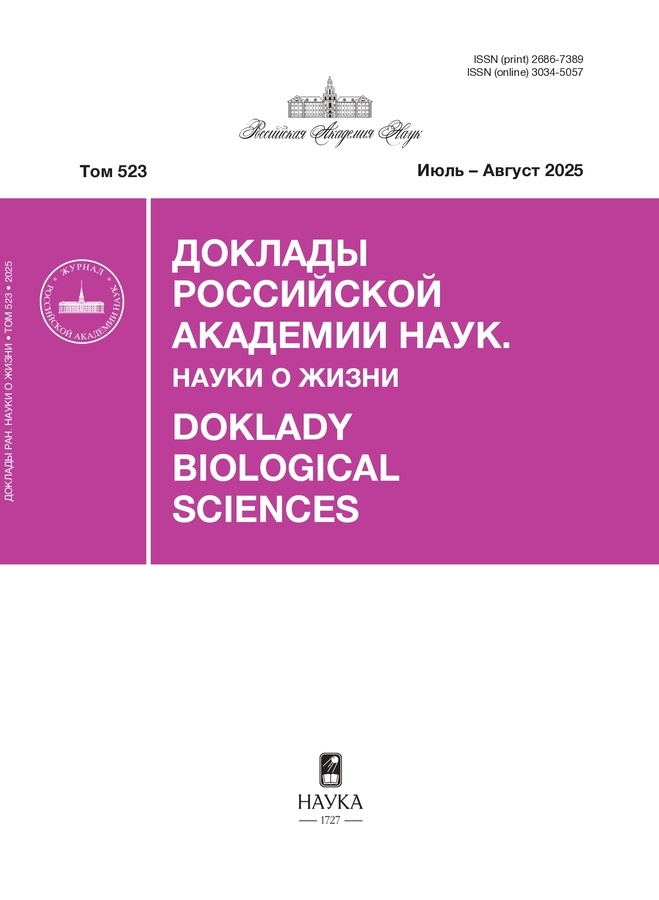The skull of Hapalodectes (Hapalodectidae, Mesonychia) from the Paleocene of Mongolia
- Authors: Lopatin A.V.1
-
Affiliations:
- Borissiak Paleontological Institute, Russian Academy of Sciences
- Issue: Vol 519, No 1 (2024)
- Pages: 5-16
- Section: Articles
- URL: https://gynecology.orscience.ru/2686-7389/article/view/651374
- DOI: https://doi.org/10.31857/S2686738924060011
- ID: 651374
Cite item
Abstract
The incomplete skull of Hapalodectes (Hapalodectidae, Mesonychia) is described from the Upper Paleocene Naran Member of the Naran Bulak Formation of the Khaychin-Ula 2 locality in the Bugin Tsav Basin in the south of Mongolia. This is the first discovery of the skull of a Paleocene member of the genus. The skull corresponds in size and dental occlusion to the species H. dux Lopatin, 2001, previously known only from a lower jaw from the Upper Paleocene Zhigden Member of the Naran Bulak Formation of the Tsagan-Khushu locality in the Nemegt Basin. In the structure of the facial part of the skull, H. dux exhibits features shared with Mesonychidae, namely the significant participation of the lacrimal and jugal in the preorbital region. The upper molars of H. dux were found to have distinct conules (a first for Hapalodectidae). The evolutionary changes in the structure of the upper molars of Hapalodectes (disappearance of the conules, decrease of the metacone, and narrowing of the lingual lobe) are determined. They were correlated with the transformations of the lower molars (reduction of the metaconid, protocristid, and entoconid, transverse compression of the trigonid and talonid) and together with them were aimed at enhancing the shearing action of the longitudinal blades of the posterior part of the dentitions.
Keywords
Full Text
About the authors
A. V. Lopatin
Borissiak Paleontological Institute, Russian Academy of Sciences
Author for correspondence.
Email: alopat@paleo.ru
Academician of the RAS
Russian Federation, MoscowReferences
- Лопатин А.В. Новый вид Hapalodectes (Hapalodectidae, Mesonychia) из палеоцена Монголии // Доклады Российской академии наук. Науки о жизни. 2023. Т. 513. С. 521–527.
- Solé F., De Bast E., Yang J. et al. The first species of Hapalodectes (Mesonychia, Mammalia) from the middle Paleocene of China (Qianshan Basin, Anhui Province) sheds light on the initial radiation of hapalodectids // Palaeontology. 2017. V. 60. № 3. P. 433–449.
- Beard K.C., Wang Y.-Q., Meng J. et al. Paleocene Hapalodectes (Mammalia: Mesonychia) from Subeng, Nei Mongol: further evidence of “East of Eden” dispersal at the Paleocene-Eocene boundary // Vertebrata PalAsiatica. 2010. V. 48. № 4. P. 375–389.
- Лопатин А.В. Древнейший Hapalodectes (Mesonychia, Mammalia) из палеоцена Монголии // Палеонтологический журнал. 2001. № 4. С. 90–96.
- Лопатин А.В. Зубная аномалия у Hapalodectes dux (Hapalodectidae, Mesonychia) из позднего палеоцена Монголии // Доклады Российской академии наук. Науки о жизни. 2023. Т. 512. С. 474–479.
- Zhou X., Gingerich P.D. New species of Hapalodectes (Mammalia, Mesonychia) from the early Wasatchian, early Eocene, of northwestern Wyoming // Contributions from the Museum of Paleontology, University of Michigan. 1991. V. 28. № 9. P. 215–220.
- O’Leary M.A., Rose K.D. New mesonychian dentitions from the Paleocene and Eocene of the Bighorn Basin, Wyoming // Annals of the Carnegie Museum. 1995. V. 64. № 2. P. 147–172.
- Guthrie D. The mammalian fauna of the Lysite Member, Wind River Formation (early Eocene), of Wyoming // Memoirs of the Southern California Academy of Sciences. 1967. V. 5. P. 1–53.
- Szalay F.S., Gould S.J. Asiatic Mesonychidae (Mammalia, Condylarthra) // Bulletin of the American Museum of Natural History. 1966. V. 132. Art. 2. P. 129–174.
- Szalay F.S. The Hapalodectinae and a phylogeny of the Mesonychidae (Mammalia, Condylarthra) // American Museum Novitates. 1969. № 2361. P. 1–26.
- Ting S., Li C. The skull of Hapalodectes (?Acreodi, Mammalia), with notes on some Chinese Paleocene mesonychids // Vertebrata PalAsiatica. 1987. V. 25. № 3. P. 161–186.
- Ting S., Wang Y., Schiebout J.A. et al. New Early Eocene mammalian fossils from the Hengyang Basin, Hunan China // Bulletin of Carnegie Museum of Natural History. 2004. № 36. P. 291–301.
- Tong Y., Wang J. Fossil mammals from the Early Eocene Wutu Formation of Shandong Province // Palaeontologia Sinica. New Ser. C. 2006. № 28. P. 1–195.
- Бадамгарав Д., Решетов В.Ю. Палеонтология и стратиграфия палеогена Заалтайской Гоби. М.: Наука, 1985 (Тр. ССМПЭ. Вып. 25).
- Dashzeveg D., Russell D.E. Palaeocene and Eocene Mixodontia (Mammalia, Glires) of Mongolia and China // Palaeontology. 1988. V. 31. № 1. P. 129–164.
- Kondrashov P., Lopatin A.V. Late Paleocene mixodonts from the Tsagan-Khushu locality, Mongolia // Journal of Vertebrate Paleontology. 2003. V. 23. Suppl. to № 3. P. 68A (Abstracts of papers. 63rd Annual Meeting of the Society of Vertebrate Paleontology. St. Paul, Minnesota, October 15–18, 2003).
- Zhou X., Zhai R., Gingerich P.D., Chen L. Skull of a new mesonychid (Mammalia, Mesonychia) from the Late Paleocene of China // Journal of Vertebrate Paleontology. 1995. V. 15. № 2. P. 387–400.
- Geisler J.H., McKenna M.C. A new species of mesonychian mammal from the lower Eocene of Mongolia and its phylogenetic relationships // Acta Palaeontologica Polonica. 2007. V. 52. № 1. P. 189–212.
- Jin X. New mesonychid mammals found from Lower Paleogene of Erlian Basin, Nei Mongol // Vertebrata PalAsiatica. 2012. V. 50. № 3. P. 245–257.
- Solé F., Godinot M., Laurent Y. et al. The European mesonychid mammals: phylogeny, ecology, biogeography, and biochronology // Journal of Mammalian Evolution. 2018. V. 25. P. 339–379.
Supplementary files















